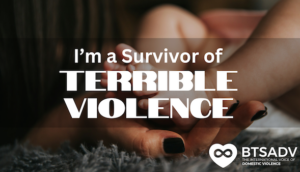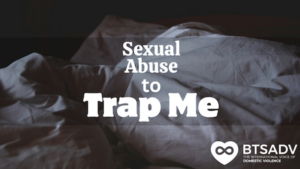We have all heard the phrase, “What doesn’t kill you makes you stronger.”
As survivors of domestic violence, this saying can be hard to grasp. It can leave you wounded, with both visible and invisible scars. It can sometimes be hard to imagine you will ever recover from the trauma you faced, let alone come back stronger.
However, as much as it doesn’t feel like growth is occurring, data states otherwise. Studies show that about 71% of interpersonal violence survivors experience some type of Post Traumatic Growth (PTG) [1]. Thousands of survivors have learned not just to survive but to thrive. They have used the pain inflicted by their trauma as an avenue to find new meaning in their life.
From Trauma to Opportunity
In short, PTG is a positive transformation that occurs in the life of many survivors of intense trauma.
People who experience PTG do not merely bypass the negative consequences of trauma. Instead, the emotional battle is what challenges survivors to reevaluate their perception of life. This new perception works as a catalyst for positive growth [1].
In other words, the aftermath of trauma can change your mindset (in a good way). It can alter the lens through which you view the world. It is like a photographer who adjusts their lens and angle to see the most powerful possible shot. People experiencing PTG choose to react to their trauma in a way that allows them to see the best in their situation.
According to the Post Traumatic Growth Inventory, people typically experience PTG in one or more of the following ways.
- A new, enhanced appreciation for life.
- Improved social relationships and an increase in positive emotions derived from the relationships.
- An openness to new possibilities/opportunities in life.
- An increase in mental resilience and personal strength.
- Spiritual connection.
The Journey of Post Traumatic Growth
There is no timeline for coping, healing, or growth. Every survivor’s experience is different, and that’s okay. PTG usually occurs naturally, and unfortunately, not everyone experiences it.
However, there are five evidence-based ways to help facilitate growth:
Education
Growth after trauma requires some serious self-reflection. You may not be the same person you were before the trauma, and you have to face the reality of determining your new identity. Also, many of your perceptions about life have likely changed.
The first thing to facilitate growth is to acknowledge these changes and understand that your situation will require you to view your circumstances in a new, positive way. You need to try to change your mindset while at the same time, allow compassion for yourself and your trauma.
Disclosure
Talking about trauma can feel like a release. It can also help you make sense and find meaning in the trauma. There are many different ways you can talk through and process your trauma. You can try counseling, venting with family/friends, joining a support group, sharing your story on a blog/domestic abuse network, or starting a journal. You could even record yourself or talk to yourself in an empty room.
Service
Helping others has profound benefits for your mental health and healing. To add, it can give you a sense of self-worth, accomplishment, and gratitude. It can also aid in finding meaning in your trauma.
Consider doing service directly with causes associated with the trauma you went through—such as being a domestic violence advocate or starting a blog about your grief and growth.
Emotional Regulation
Regulating the intense emotions you feel after a traumatic event can be difficult; but, trying to experience PTG when surrounded by negative emotions is impossible. You should refrain from dwelling on your negative emotions– try your best to frame things positively. Instead of focusing on your situation’s negatives, consider what you have gained through your experience– perspective, a fresh start, an opportunity to learn and grow.
Another practice that can assist with emotional regulation is breathing, mediation, and acknowledging/observing emotions while you are experiencing them.
Narrative Development
You are solely in charge of deciding what your story will be and what your trauma means. It is an individual choice to focus on the negatives and talk about everything you lost from the abuse or grief. You can also acknowledge those losses while choosing to focus on the positive things you learned from the trauma and the growth you experienced.
Lessons from a Broken Cup
The Japanese have a tradition called kintsugi, which means “golden repair.” It is the ancient art of putting broken pottery dishes back together using gold [4] causing the pottery to be more beautiful and worthy than before it suffered the break.
Likewise, you can use the trauma you endured as a way to recreate yourself in a beautiful, strong way. You can experience post-traumatic growth.
Viewing the World Through a New Lens
“Thoughts could leave deeper scars than almost anything else.”
J.K. Rowling, Harry Potter and the Order of Phoenix
It’s essential to recognize that you are not defined or controlled by your traumas.
Unfortunately, no one can take away the trauma or pain you endured, but you can choose how to react to what the world has handed you. It is up to you to change your mindset and decide to frame your life experiences positively.
Remember, broken things can transform into something even more beautiful. And you–survivors and Legacy Families— can thrive after trauma.
A Note From The Author:
Let this serve as an inspiration. None of this is to say that the abuse you experienced or the loved one you lost to an abusive relationship ended up being a blessing in disguise. Anyone who experiences post-traumatic growth realizes the cost. Most likely, most would happily give up all the growth if they could change the truth of their trauma.
Not everyone experiences growth after trauma, and that’s okay. It does not mean you are not a survivor, and it does not mean you will not thrive.
The growth you experience does not make your suffering any less valid.
References
- Elderton, A., Berry, A., & Chan, C. (2017). A Systematic Review of Posttraumatic Growth in Survivors of Interpersonal Violence in Adulthood. Trauma, Violence & Abuse, 18(2), 223-236. doi:10.2307/26638176
- Tedeschi, R. G., & Calhoun, L. G. (1996). The Posttraumatic Growth Inventory: measuring the positive legacy of trauma. Journal of traumatic stress, 9(3), 455–471. https://doi.org/10.1007/BF02103658
- Tedeschi, R. G. (2020). Growth after trauma. Harvard Business Review. https://hbr.org/2020/07/growth-after-trauma#:~:text=Although%20posttraumatic%20growth%20often%20happens,%2C%20narrative%20development%2C%20and%20service.
- Mantovani, A. (2019). Kintsugi and the art of repair: life is what makes us. Medium. https://medium.com/@andreamantovani/kintsugi-and-the-art-of-repair-life-is-what-makes-us-b4af13a39921
- Rowling, J. K. (2014). Harry Potter and the order of the phoenix. Bloomsbury Childrens Books.










